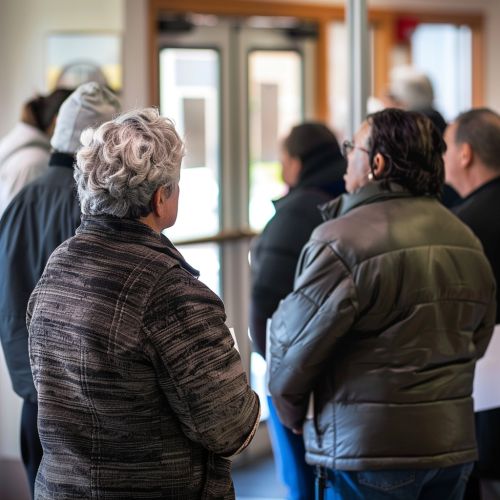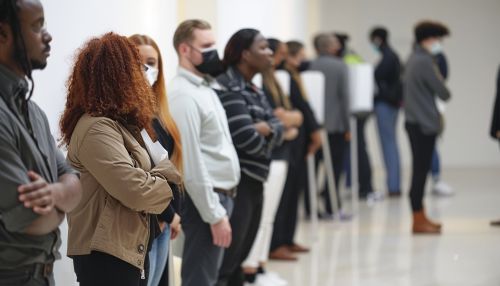Voter suppression in the United States
Introduction
Voter suppression in the United States refers to a variety of legal and extralegal measures aimed at reducing or preventing certain groups of people from voting. These measures have been employed throughout U.S. history and continue to be a significant issue in contemporary politics. Voter suppression can take many forms, including restrictive voter ID laws, purging of voter rolls, gerrymandering, and limiting access to polling places.
Historical Context
Early History
In the early years of the United States, voter suppression was institutionalized through laws that restricted voting rights to white male property owners. The Constitution of the United States initially left the determination of voter eligibility to individual states, many of which imposed property and tax requirements that effectively disenfranchised large segments of the population.
Post-Civil War Era
Following the American Civil War, the 15th Amendment was ratified in 1870, prohibiting states from denying the right to vote based on race, color, or previous condition of servitude. Despite this, Southern states implemented Jim Crow laws to disenfranchise African American voters. These laws included literacy tests, poll taxes, and grandfather clauses, which were designed to circumvent the 15th Amendment.
Civil Rights Movement
The Civil Rights Movement of the 1950s and 1960s brought significant attention to voter suppression. The Voting Rights Act of 1965 was a landmark piece of federal legislation that aimed to eliminate racial discrimination in voting. The Act banned literacy tests and provided for federal oversight of voter registration in areas with a history of discriminatory practices.


Modern Voter Suppression Tactics
Voter ID Laws
One of the most contentious forms of modern voter suppression is the implementation of voter ID laws. These laws require voters to present specific types of identification at the polls. Proponents argue that such laws prevent voter fraud, while critics contend that they disproportionately affect minority, elderly, and low-income voters who are less likely to possess the required ID.
Voter Roll Purges
Voter roll purges involve the removal of names from voter registration lists. While purges are a routine part of maintaining accurate voter rolls, they can be used to disenfranchise voters. Critics argue that purges often target minority communities and are conducted with insufficient notice, leaving voters unaware that they have been removed from the rolls.
Gerrymandering
Gerrymandering is the practice of drawing electoral district boundaries to benefit a particular political party. This can dilute the voting power of certain groups, effectively suppressing their vote. Gerrymandering can be achieved through "packing," where voters of one type are concentrated into a single district, or "cracking," where they are spread across multiple districts to dilute their influence.
Polling Place Closures
Closing or relocating polling places can create barriers to voting, particularly for minority and low-income communities. Long distances to polling places, limited hours, and inadequate facilities can all contribute to lower voter turnout.
Legal and Legislative Responses
Federal Legislation
The Voting Rights Act of 1965 remains a cornerstone of federal efforts to combat voter suppression. However, its effectiveness has been undermined by subsequent Supreme Court decisions, most notably Shelby County v. Holder in 2013, which invalidated key provisions of the Act. This decision has led to a resurgence of restrictive voting laws in several states.
State Legislation
States have enacted a variety of laws aimed at both expanding and restricting voting rights. Some states have implemented automatic voter registration, early voting, and no-excuse absentee voting to increase voter participation. Conversely, other states have passed laws that critics argue are designed to suppress the vote, such as strict voter ID requirements and limitations on mail-in voting.
Impact on Democracy
Voter suppression has significant implications for the health of American democracy. By disenfranchising certain groups, voter suppression undermines the principle of equal representation and can skew election results. This can lead to a lack of confidence in the electoral process and decreased political participation among affected communities.
Case Studies
Georgia
Georgia has been a focal point for discussions on voter suppression, particularly during the 2018 gubernatorial election. Allegations of voter roll purges, long lines at polling places, and strict voter ID laws were prominent issues. The state's "exact match" law, which required voter registration information to exactly match other state records, was criticized for disproportionately affecting minority voters.
Texas
Texas has also faced scrutiny for its voter suppression tactics. The state has some of the strictest voter ID laws in the country and has been accused of purging voter rolls in a manner that disproportionately affects minority voters. Additionally, Texas has been criticized for limiting early voting and reducing the number of polling places in certain areas.
Advocacy and Opposition
Civil Rights Organizations
Numerous civil rights organizations, such as the American Civil Liberties Union (ACLU) and the NAACP Legal Defense and Educational Fund, actively work to combat voter suppression. These organizations engage in litigation, advocacy, and public education to protect and expand voting rights.
Political Parties
The issue of voter suppression is highly partisan, with Democrats generally advocating for expanded voting rights and Republicans often supporting measures they argue are necessary to prevent voter fraud. This partisan divide has led to significant legislative and legal battles at both the state and federal levels.
Technological and Social Media Influence
The rise of technology and social media has introduced new dimensions to voter suppression. Misinformation and disinformation campaigns can spread rapidly online, confusing voters about election dates, polling locations, and voting procedures. Social media platforms have been criticized for not doing enough to combat these tactics.
International Comparisons
Voter suppression is not unique to the United States, but the specific tactics and legal landscape differ from those in other democracies. For example, many European countries have national ID systems that simplify voter identification, while others have compulsory voting laws that aim to increase voter participation.
Future Directions
The future of voter suppression in the United States will likely be shaped by ongoing legal battles, legislative changes, and technological advancements. Efforts to expand voting rights, such as the proposed For the People Act, aim to address many of the issues associated with voter suppression. However, the partisan nature of the debate suggests that voter suppression will remain a contentious issue for the foreseeable future.
See Also
- Voting Rights Act of 1965
- Shelby County v. Holder
- Gerrymandering
- American Civil Liberties Union
- Civil Rights Movement
